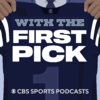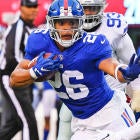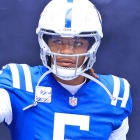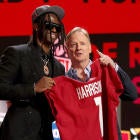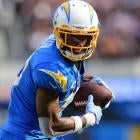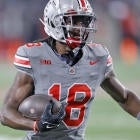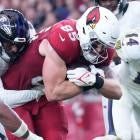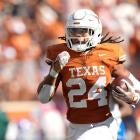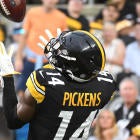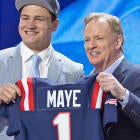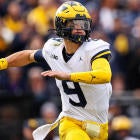You can't win your Fantasy Football league in the first round, but the wrong pick can go a long way toward losing it. If that happens because of an injury, you have to live with that. Who could have seen it coming? However, we too often draft as if these first round picks are bulletproof, and none of them — no, not even Christian Mccaffrey — are. Just ask those who made Le'Veon Bell or David Johnson their first-round pick a year ago.
That's why we're taking a look at what could go wrong for each of the players in our consensus top 12 below. Some of these scenarios are far more likely than others. Some of them require a great deal of imagination to come up with. But you'll want to read each of them and decide which downsides are enough to keep you from drafting them in 2020.
We had the same discussion on the Fantasy Football Today podcast Monday, focusing on how the top-10 projected picks in 2020 could turn out to be busts. It's harder to find a case for McCaffrey and Saquon Barkley, as you'll see, but you'll want to hear what Jamey Eisenberg and Dave Richard have to say about the whole bunch. Subscribe to the podcast to hear our discussions the rest of the week and what could go wrong for the second tier of players, plus the beginning of our position preview pods:
For the most part, we tried to leave injuries out. It's football, and any player could get hurt. But there's still plenty that could go wrong besides injuries. Here's how things could go wrong for the elite of the elite in 2020.
No. 1 — Christian McCaffrey
How it goes wrong: He becomes less of a focal point for a new coaching staff.
Matt Rhule and Joe Brady could decide they don't want to give their $64-million dollar back another 400 touches in a year they won't be competitive anyway. That could lead to a little more sharing for McCaffrey, which could be exacerbated by the Panthers' pace falling, as it often does with first-time NFL play callers. For example, Kliff Kingsbury's Cardinals ran 77 fewer plays than the Panthers in 2019.
Last year, McCaffrey saw a carry or target on 39.8% of the Panthers' plays. If that number drops below 35% (putting him in the range of almost every other back in the NFL) and the number of plays drops down to 1,000 from 1,077, McCaffrey could easily see 60-80 fewer touches than he did in 2019. Even with normal touchdown luck, McCaffrey could lose 400 yards and six touchdowns in this scenario. That would also mean he wouldn't be the No. 1 running back — in non-PPR, at least.
No. 2 — Saquon Barkley
How it goes wrong: The targets aren't there.
Barkley played nine games with Daniel Jones last year. He saw more than five targets in just three of those games and averaged just 5.6 targets per game, two fewer than Barkley saw in 2018. We expect the Giants to be a pretty bad team, so a decreased role in the passing game could be a real hit to Barkley's value. In his first two years in the league, Barkely hasn't been particularly efficient as a pass catcher, averaging right around 6 yards per target.
A drop to 90 targets over a full season would cost Barkley about 40 PPR points off his 2018 total, and that's not accounting for the fact that it may be tough to sustain his 4.8 career yards per carry mark. It's not hard to envision how a bad Giants team creates fewer opportunities for scoring, and that combined with a drop in targets thanks to playing with more of a mobile quarterback makes Barkley a solid No. 1 running back, but one who isn't worth the No. 2 pick.
No. 3 — Ezekiel Elliott
How it goes wrong: We see less of Zeke and more of Tony Pollard.
Elliott's high touchdown rate in 2019 disguised the fact that he saw a major drop in targets and averaged 10% fewer carries per game as well. Plus, Elliott's 5 yards per touch was the second lowest mark of his career. If you take just one touchdown away from his 2019 line, Elliott falls to sixth on a per-game basis in scoring. Kellen Moore's offense, while great for the Cowboys offense as a whole, may not be particularly great for Elliott.
Tony Pollard presents an additional problem. He was effective as a rookie and gives the Cowboys a legitimate option to spell Elliott without losing much on the field. Pollard's snap share was over 30% in a pair of blowout victories late in the season, and he averaged eight touches per game over the final seven games. If Pollard's snap share goes up at all, Elliott will have a hard time justifying a top-five ADP.
No. 4 — Alvin Kamara
How it goes wrong: He doesn't have super-human efficiency.
When a back is drafted in the top five and averages just 18 touches per game (Elliott's career-low mark in 2019 was still north of 22 touches per game) there are plenty of things that can go wrong. Just ask Kamara in 2019. You need Kamara to either be as hyper-efficient as he was in 2017 or you need him to find the end zone at an absurd rate, as he did in 2018.
There will be some touchdown regression, but there's also a real risk Kamara sees a decline in targets with Emmanuel Sanders as another option and the likelihood the Saints throw less often than they did in 2019. He's averaged 5.5 yards per touch over the past two seasons. If Kamara is at 275 touches, that's not top-five worthy unless it comes with a ton of touchdowns. Unlike McCaffrey, Barkley and Elliott, Kamara doesn't have the touch security to guarantee first-round value in non-PPR.
No. 5 — Michael Thomas
How it goes wrong: There's more competition for targets.
One of the things we can feel most confident in heading into 2020 is that Michael Thomas will not get 185 targets again this season. Alvin Kamara is back to 100%, Emmanuel Sanders is now on the team, and the Saints probably won't have as many team pass attempts as they did last year either. How far that target total falls will tell us just how wrong things could go.
We saw Thomas have 147 and 149 targets in 2017 and 2018, and he wasn't a top-five receiver (even in PPR) either season. Part of the reason for that is Thomas has never been an elite red zone option. His career touchdown rate hovers right around 5%, but it was down to 3% in 2017. What could go wrong seems pretty obvious: If Thomas' targets fall back around 150 and his touchdown rate stays at or below his career average, you'll wish you hadn't spent a first-round pick on him. If his absurd catch rate falls too? He'll be a flat-out bust.
No. 6 — Dalvin Cook
What could go wrong: He just can't handle the full-time job.
We're doing our best to stay away from talking about injuries here, but Cook has missed 19 games in three seasons. It seems relevant to this discussion. And with the success Alexander Mattison had last year, it wouldn't be surprising to see the youngster get just a few more touches as the Vikings try to get Cook through an entire season injury-free.
Now, if the Vikings are as good as they were in 2019, there will be enough volume for Cook to be awesome even with Mattison more involved. But another thing that could go wrong is that the Vikings defense could regress little and Minnesota could be forced into passing mode more often. Cook does plenty in the passing game, but a more pass-heavy offense would still be an overall negative for him.
Finally, there's a little bit of a concern about Cook's contract situation. There have been rumors of a holdout if he doesn't get a new deal. Cook doesn't actually have very much leverage here, but he wouldn't be the first running back to hold out and make things worse for himself. Stay tuned.
No. 7 — Davante Adams
What could go wrong: His QB just isn't elite anymore.
The Packers behaved this offseason as if they don't really have much interest in throwing the ball anymore. That's good for Adams in that he's still the only viable receiver, but it will be bad if they only throw the ball 500 times and his target share falls below 30%. Adams has never averaged better than 8.2 yards per target in any season, and his career mark is 7.5 That's mediocre at best and means that he has to have a ton of targets if he's going to top 1,000 yards for the second time in his career.
Of course, it's not just Adams' efficiency that matters. His 36-year-old quarterback hasn't averaged better than 7.4 yards per attempt since 2014 and his touchdown rate has been below 5% each of the past two seasons. It's quite possible Aaron Rodgers just isn't an elite quarterback anymore.
No. 8 — Julio Jones
What could go wrong: Father Time catches up to him. Or Calvin Ridley does.
There will come a time when age catches up to Julio Jones, who turned 31 in February. That's the first, and most obvious way things could go wrong. Jones' 8.9 yards per target in 2019 was still elite, but it was also the lowest mark of his career. It was 10% worse than his career average. If Jones' efficiency dips again in 2020, he'll struggle to finish among the top-five receivers.
Of course, if Jones loses another 10% of efficiency he may have bigger problems because Calvin Ridley may just overtake him as the team's No. 1 receiver. Ridley saw his role grow in 2019 and he's at the stage of his career where that should only continue. In 2016 and 2017, Jones averaged about nine targets per game. If he falls back to that volume and his efficiency doesn't bounce back, he could fall out of the top 12 due to his poor touchdown history.
No. 9 — Tyreek Hill
What could go wrong: Maybe the Chiefs have too many weapons.
This is not an easy exercise with Hill. Yes, there's the off-field stuff. No one wants to speculate on that type of thing, but his history does make him more likely to end up on the commissioner's exempt list or worse. But outside of that, and injuries, it's not easy to concoct a down year for Hill.
The Chiefs could just thoroughly dominate opponents and lower their pass rate. Mecole Hardman and Clyde Edwards-Helaire could cut into Hill's short area targets, leaving him as more of a boom-or-bust deep threat. Travis Kelce and Sammy Watkins could dominate in the red zone and Hill's absurd 7.7% touchdown rate could plummet. While none of those seem particularly likely, any one of them would knock Hill outside of the top-five receivers. And if two happen, he may not be a No. 1 receiver in Fantasy.
No. 10 — Miles Sanders
What could go wrong: Maybe it's more of a timeshare than we think.
Anyone drafting Miles Sanders in the first round may need a reminder that the Eagles went into last season with Jordan Howard as the No. 1 back, and Sanders' end-of-season surge came only after Howard suffered a season-ending injury. So far Boston Scott is the only competition Sanders has for a feature role, but Devonta Freeman and Lamar Miller are still free agents.
Even if the Eagles don't bring in anyone else, it's worth noting Sanders was the first running back in the Doug Pederson era to top 200 touches. This will be a committee, and it's really hard to justify a first-round ADP on a back with fewer than 250 touches unless that back is extremely efficient.
That efficiency could be a problem with the Eagles losing a starting offensive lineman from 2019. Even if Sanders gets 60% of the running-back touches, that may not be enough if he sees serious regression from the 4.6 yards per carry and 8.1 yards per target he posted in 2019. There's also a risk that the Eagles now have enough wide receivers that they won't use their backs as much in the passing game.
With Pederson's history and question marks on the offensive line, there are plenty of ways things could go wrong for Sanders.
No. 11 — Austin Ekeler
What could go wrong: He's still a gadget back.
If Sanders has the most ways that something could go wrong of anyone in the top 12, Ekeler has the most obvious. He's never had more than 132 carries in a season, and 132 carries isn't close to enough to justify a first-round ADP. The Chargers have Justin Jackson and drafted Joshua Kelley, so if they give most or all of the Melvin Gordon role to those two backs, Ekeler will not justify this ranking because he almost certainly won't repeat last year's efficiency.
One other way things could go wrong is if Tyrod Taylor starts 16 games for the Chargers and passes at the same rate he did in Buffalo, as he never averaged even 30 passes per game for the Bills. If that carries over to 2020, Ekeler could lose 20% of his targets. Combine that with the more obvious risk scenario above and Ekeler could fall outside of the top-20 backs in all formats.
No. 12 — Kenyan Drake
What could go wrong: It was all a fluke.
We've done this before. In the final five games of the 2017 season Drake was the No. 8 running back in Fantasy. He was on everyone's breakout list heading into 2018 and then received just 120 carries in 16 games. What could go wrong in 2020 is what already went wrong for him in 2018. Thankfully, Adam Gase will not be involved with the Cardinals' decision making in 2020.
As is the case with Sanders and Ekeler, it's risky to draft a running back in the first round when that running back has never had a 250-touch season. Even if Drake does hold up to the increased workload, he's not risk free. The Cardinals could become the pass-happy team we expected last season. Also, Chase Edmonds could see more targets than Drake because he was much better on a per-target basis in 2019. If Arizona throws it 600 times and Edmonds is the primary pass-catching back, Drake is going to have a very difficult time justifying a pick in the first two rounds, much less the first.




